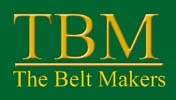Leather

TBM’s Leather of choice
Choosing to use the best… of the best
Some say… TBM are fussy about the leather they use.
Cows are natural creatures and do not grow in tidy rectangles, nor do they go out of their way to avoid scraping themselves on such things as barbed wire fences.
There are many good leather dressers in the world and their job is to make the best of these skins.
Sedgwick’s First Selection
Sedgwick & Co was established in 1900, providing the best British bridle leather to the equestrian trade. Now, proudly and protectively owned by a consortium of three family businesses in the UK, Ireland and Europe and based in Walsall, Birmingham (home of traditional English saddlery and harness) they are known throughout their industry as being arguably the best leather dressers in the world. They have a small, select number of outlets across the globe, to which they supply their traditionally tanned products. Their main UK distributor holds a Royal Warrant for the provision of saddlery materials to the Crown and is the source of most of TBM’s raw materials.
For those who know leather, simply to handle this luxury item makes them look up and smile.
Sedgwick’s best bridle leather is world renowned for its reliable strength, durability, density and lustre.
TBM are pleased to put their stamp in this, their leather of choice.
The best way to appreciate such a traditionally manufactured material is to employ traditional belt making methods so all TBM belts are handmade rather than hand machined. Please see belt making for more information on this.
Leather is, of course, a natural material and part of the beauty is that a little slight marking and colour variation are expected. No two natural belts can ever be the same.
Leather Making
The traditional vegetable tanning process has been in use for centuries and uses tannins that occur naturally in plants and trees. It’s environmentally friendly, especially when compared to chrome tanning, and it can take a year and a day to turn each hide from skin to leather. During this process, tallow is introduced to the skins to replace moisture lost; in turn the tallow protects the leather during our work on the item. Waxy tallow residue can come to the surface of the skin over time and each belt is brushed well before it goes to its new owner, however, some tallow may still rub off onto clothing during the first few occasions that the belt is worn. This is normal and should brush off the clothing or wash out without any trouble. Simply brush the leather gently with a clean shoe brush to reveal the natural lustre.
Leather Wear
As the belt is worn in, in a similar way to wearing in new boots and shoes, the leather will react to the natural oils in your hands and to your body heat, becoming more supple over time. Subsequently, as it moulds beautifully to your shape and develops its unique natural patina, it will result in a wonderfully personal leather accessory, thus making it a firm favourite for years to come.
Leather Care
As one might expect from leather, care should be taken when exposing these products to hot and damp conditions and very light coloured fabrics, as colour transfer may occur.
Feeding your belt may become necessary, for example if it is stored in very warm, dry conditions such as on a sunny window sill or in an exposed or centrally heated environment. TBM recommend Sedgwick’s own Leathercare product which can be applied as necessary.
The Leather Colours
TBM carry ten traditional Sedgwick bridle butt colours; black and five earth tones are complimented by the addition of red, blue, green and burgundy.
White and other guest colours are available from time to time, please do ask if you can’t find what you’re looking for.
Bright colours
When a traditional leather colour just won’t do, we choose a specialist supplier in Northamptonshire for their finishing services. Using Spanish and Italian traditionally vegetable tanned, unfinished skins, they use a hand sprayed, water-based colouring technique to bring us some stunning shades. They are particular about their sources and proud of their products.
